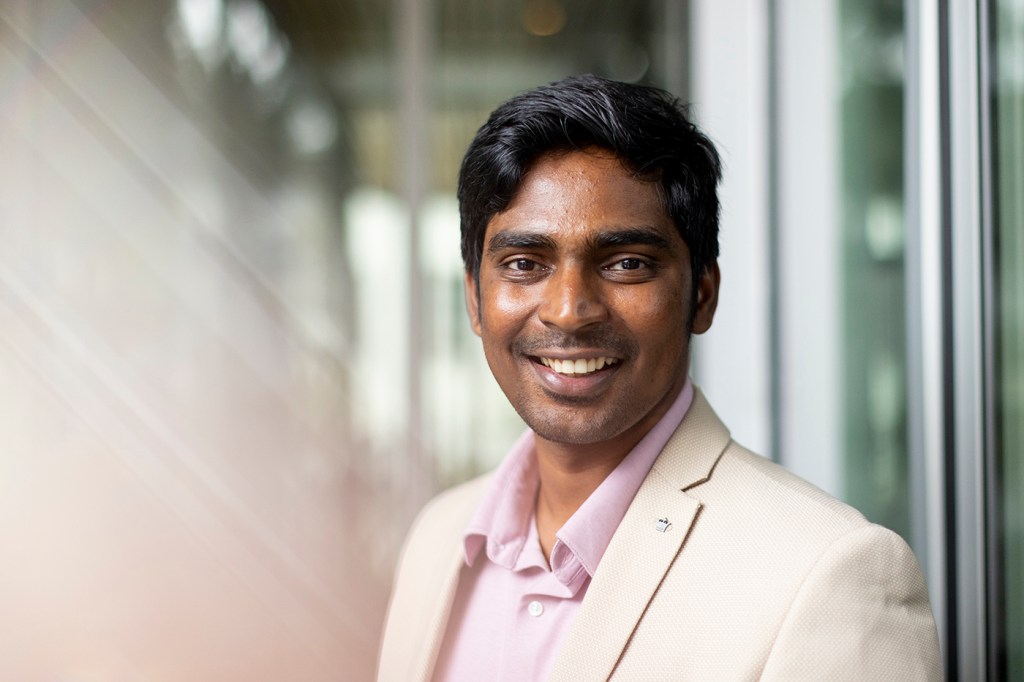Northeastern researcher wins NSF award to cut costs and boost efficiency of quantum computing
Aravind Nagulu, a professor of electrical and computer science, wants to cut qubit costs for AI, cryptography, drug discovery and energy research.

Oakland, Calif. — Chances are the phone in your pocket is smaller than the one you owned a few years ago. The same trend applies to other personal computers and electronic devices. However, modern semiconductor components are about as small as they can get, sparking growing interest in new computing modalities such as quantum computing.
“We are at the limit of miniaturizing standard technology,” said Aravind Nagulu, assistant professor of Electrical and Computer Science at Northeastern University.
While traditional computers use “bits” to store and process information, quantum computers rely on “qubits.”
“Generally speaking, if you add more resources to a digital computer, the benefits scale linearly,” Nagulu explained. “But in a quantum computer, if you do it the right way, the benefits scale exponentially as you add more qubits.” This makes it possible to conduct more powerful computations using fewer resources.
The quantum computing market was valued at more than $13 billion in 2022, Nagulu noted, and is projected to exceed $143 billion by 2032. This growth is expected to accelerate breakthroughs in artificial intelligence, cryptography, financial fraud detection, and energy research.
In Nagulu’s lab, graduate student researchers are focused on designing and fabricating the semiconductors that are foundational to the chips that store and process data. While traditional chips are made from silicon, qubits are made from trapped ions, photons or atoms. They are “feeble,” Nagulu said, and highly sensitive to noise.
And noise grows louder as temperatures go up, Nagulu said. Therefore, colder conditions improve qubit superconductivity.
By cold, he means really, really cold. Currently, the transmon qubits that his lab is focused on operate at 10 Kelvin — more than 400 degrees below zero. Nagulu’s lab is working to figure out a way to reduce that temperature to 4 Kelvin.
Achieving these low temperatures requires a dilution refrigerator, which can cool supercomputing chips to almost absolute zero. The challenge, Nagulu said, is to make the rest of the process cold too. This includes the microwave pulses necessary to communicate with qubits, which currently reach the chip at room temperature. Cooling the pulses so they are closer to the temperature of the qubit would make designing the transistors cheaper, more efficient and quieter.
Editor’s Picks
Nagulu recently received a National Science Foundation (NSF) CAREER Award to investigate scaling quantum computers. With the $500,000 award, his lab at Northeastern’s Institute for NanoSystems Innovation on the Oakland campus will explore placing compact, low-power integrated circuits inside the dilution refrigerator. This integration is expected to reduce costs, simplify the system, and improve scalability for quantum computers.
His lab will also address the challenges of bulky ferrite circulators used in quantum systems. These off-the-shelf microwave components, which provide signal isolation for qubits, are expensive and take up significant space inside dilution refrigerators because they cannot be integrated onto semiconductor platforms. To solve this, Nagulu’s lab will explore time-modulated superconducting circulators that do not rely on ferrite materials.
“If we can create compact and cost-effective superconducting circulators, quantum computers could scale to larger numbers of qubits without requiring larger refrigerator space,” Nagulu said. “The research in quantum hardware is scaling rapidly, and its potential impact spans everything from medicine and drug development to complex chemical computations.”
As the field expands, the demand for skilled engineers will also grow. Quantum computing is inherently interdisciplinary, requiring collaboration among computer scientists, engineers, and physicists.
“Often, research is hindered because researchers in one discipline don’t fully understand the needs of another,” Nagulu said. To bridge this gap, he plans to develop an undergraduate course that integrates circuit design and quantum systems.
“Some theories of quantum mechanics aren’t covered substantially in electrical engineering courses,” he said. His course will focus on understanding qubits from a circuit perspective, creating a bridge between electrical engineering and quantum computing disciplines.










